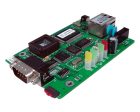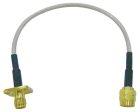Product Description
The Parani-BCD210 Starter Kit is an evaluation and testing board for a Parani-BCD210 Bluetooth Class 2 OEM module.
The BCD210 supports Class 2 Bluetooth transmission level for shorter communication distance up to 300m at line-up sight. The BCD210 supports UART, USB, I2C, PCM, PIO interfaces for the communication with the OEM products.
The Parani-BCD210 is a low power embedded Bluetooth Class 2 OEM SMD/DIP module combining antenna for OEM manufactures who want to implement Bluetooth Class2 functionality with their products cost effectively and also in timely manner.
BCD210 – APPLICATIONS
– High-speed data transceiver systems for short distance communication
– PCs/Personal Digital Assistants (PDA)
– Bluetooth USB dongle
– Bluetooth serial dongle
– Bluetooth access points
– Industrial automation devices
– Automotive applications
– Medical Systems
– Remote metering devices
– POS (Point-of-sales) devices
The BCD210 is provided with Bluetooth v2.0 EDR compatible firmware runs internally for SPP (Serial Port Profile) applications by default. The SPP firmware supports up to 4 simultaneous multiple connections and is designed to work out-of-box for real world SPP applications such as POS (Point-of-sales), industrial automation, remote metering and other various applications. Optionally, the BCD210 can be supplied with only software stack up to HCI level so entire Bluetooth stack runs on the host side for the application such as USB dongles for computers or OEM manufacturers can even develop and embed their own firmware into the BCD210.
The BCD210 is fully qualified with Bluetooth v2.0 EDR specification so OEM manufacturers can save cost and time for overall OEM product certifications, which makes the BCD210 ideal solution for larger volume and cost sensitive applications.
Overview
BCD210 series
Bluetooth Class 2
Bluetooth v2.0 EDR specification
Low Power consumption: 30mA @3.3VDC
Transmit Power: 4dBm Typical
Receive sensitivity: -84dBm (0.1% BER)
Integrated 8Mbit Flash Memory
Supports Serial Port Profile (SPP)
Working distance (In an open field): Nom.50m, up to 300m
Supports chip, stub and dipole antennas
802.11 co-existence
Standard HCI over UART or USB
Field-proven SPP (Serial Port Profile) firmware supporting up to 4 simultaneous multiple connections
Firmware upgrade via windows-based software (ParaniUpdater)
Easy to use Windows configuration tool available.
ROHS compliant
Tech Specs
BCD210 series
Bluetooth v2.0 EDR
Class2
Profile: SPP(Serial Port Profile)
Working distance:
By default antenna is 50m (0.031 mile), Supports up to 300m (0.186 mile)
Transmit Power: 4dBm Typical
Receive Sensitivity: -84dBm (0.1% BER)
TX Output Spectrum Frequency range: 2402 MHz – 2480 MHz
Interfaces: UART, USB, I2C, PCM, PIO
Serial Interfaces:
– Serial UART speed up to 921.6kbps,
– CTS/RTS flow control,
– DTR/DSR for loop-back & full transfer
Pin Interface:
– BCD210Sx: 1.27mm SMD Pad 18 x 2 (36pin)
– BCD210Dx: 1.27mm Pin Header 18X2 (36pin)
USB Interface: V2.0
Configuration: ParaniWIN, ParaniWizard, Modem AT command set
Firmware Update: ParaniUpdater
Power:
Nominal : 30mA@3.3Vdc
Maximum :
60mA@3.3Vdc
(100mA@3.3Vdc in Test Mode)
Environmental:
– Operating temperature: -40°C ~ 80°C
– Storage temperature: -40°C ~ 85°C
– Humidity: 90% (Non-condensing)
Physical properties:
Parani-BCD210 Dimensions
– DIP type: 14.8(W) x 28.0(L) x 8.0(H) mm (0.661 in x 1.102 in x 0.315 in)
– SMD type: 14.8(W) x 28.0(L) x 3.0(H) mm (0.583 in x 1.102 in x 0.118 in)
Weight
– Parani-BCD210SC: 2g
– Parani-BCD210SU: 2g
– Parani-BCD210DC: 3g
– Parani-BCD210DU: 3g
– Parani-BCD210DS: 5g
Approvals: FCC, CE, IC, KC, TELEC, SIG
Warranty: 1-year limited warranty
Bluetooth v2.0 supports improved AFH function. AFH function is to mitigate the interference between WiFi and Bluetooth radios by automatically avoiding the active WiFi channel from Bluetooth link. However, AFH does not provide a complete solution making WiFi and Bluetooth work together in harmony. It is highly recommended for users to test their wireless system enough before deployment since the overall system performance is affected by various environmental factors such as distance between them.







